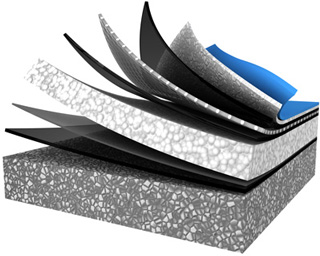Materials transparency refers to an advocacy movement that promotes requiring manufacturers to fully disclose the material content and chemical makeup of products used in the construction of the built environment. The disclosure is in reference to a pre-determined list of substances that have been identified for potential harmful impacts to human health and the environment.
A major goal of requiring materials transparency is to force product manufacturers to divulge the contents of their products to allow for assessment of the potential lifecycle health and environmental impacts posed by the use of specific products. There is also a second goal: with disclosure, many manufacturers must reconsider their formulations, redirect their supply chains, and create less hazardous alternatives to their existing products.

Recognizing the movement and the professional response
The movement to promote the disclosure of the contents of building materials and the related potential health and environmental effects has grown as clients consider eliminating certain substances from consideration for their projects. In addition, USGBC’s current LEED rating system includes optional credits for collecting product environment and health information. Other rating systems and voluntary standards for the design and operations of buildings reference health product disclosures and other specific requirements. Thus, for clients that care about such third-party validations, the existence of disclosure information becomes important.
Some architecture firms—mostly the mega-firms that work with large clients—have differentiated their design services by advertising their commitment to only specifying materials that have their contents disclosed and that have disclosure forms which do not include suspect materials in the product’s composition. These firms have signed “transparency policy statements” that commit the firms to assessing the recorded and reported content of building products and materials during their selection and recommendation of use to the project owner.
Following the lead of the AIA Board
In 2014, the AIA Board approved a policy statement to address and encourage materials transparency. The AIA pronouncement states that the architect should be environmentally responsible and that knowledge of the life cycle impacts of building materials “is integral to improving the craft, science, and art of architecture” because building materials impact the environment and human health “before, during, and after their use.” The AIA position on materials transparency is suggestive of several ways that architects are encouraged to respond to the ethical imperatives for materials transparency—the AIA’s Code of Ethics and Professional Conduct includes an obligation that AIA members be environmentally responsible and advocate for sustainable buildings.
While the advancement of professional ethics seems to be one goal of the AIA’s public policy, it also recognizes that the materials transparency movement represents an opportunity to give architecture firms a competitive advantage to tap their “thought leadership” and stimulate design innovation. This “advancement” argument by the AIA should apply to architecture firms of all sizes. But, according to Victor which manages the AIA Trust-sponsored CNA professional liability insurance program, with innovation and leadership comes business and professional exposures that must be managed.
Victor monitors claims against architects and expects that a statement by the AIA Board, while it may not alter the standard of care expected of architects, could influence the services provided by architecture firms in the future and has the potential to cause an evolution in the standard of care for professional services.
Understanding the limitations of professional practice
In developing its policy on professional services relating to materials transparency, the AIA Materials Knowledge Working Group asserts, “Architects, based on education, training and licensure requirements, lack the knowledge, expertise and ability to assess the environmental and human health impacts of varying types and quantities of substances contained in building products” (see AIA Document B503 Guide to Amendments). Notwithstanding, when product content is disclosed, architects may interpret, document, and apply the reported data knowledge in their specification services. They may also work with building owners who engage independently qualified professionals to analyze the products and to provide information on restricted compositions. By relying on the information provided by these qualified professionals, architects can guide owners in approving recommended products or rejecting products with disclosed harmful substances.
Disclosure documents are typically requested in one of three scenarios:
- the architecture firm has an internal policy on specification of materials and products;
- external influences, such as the third-party accreditation of projects as meeting some criteria measuring “wellness;” or
- the owner’s project requirements or sustainability statement requires the disclosure documents.
Whatever the scenario, architects need to carefully manage the professional liability risks of materials transparency.
Addressing the service and risk through contract language
Victor maintains that, absent specific contract language, an architecture firm’s involvement and reliance on a manufacturer’s disclosure documents will be judged in relation to the standard of care for the professional services performed. The question to be addressed is whether the actions and services of the architecture firm are consistent with what is generally accepted as being within their professional expertise and training. Architecture firms could unwittingly negate the protection of the standard of care by contractually agreeing to provide a level of assessment that is beyond the standard of care, thereby extending their business risks beyond professional liability insurance coverage. Model contract language, developed through the AIA Contract Documents program, was created to address some of these issues. That language is included in AIA document B503, which is available for free from the AIA Contract Documents website.
Clearly communicating the services provided
Victor warns that while a carefully crafted professional services agreement can clarify the role of the architecture firm, it cannot, by itself, protect against third-party claims. When health and environmental aspects of building products and materials become an increasingly important factor in the specification process, the likelihood of a third-party claim increases.
Product content and composition are important factors among many that an architect considers before recommending the use of a product, material, or system to a client. Project owners have to be made aware of the myriad other considerations that go into the specification process. With proper contract language and client communications, architecture firms can promote the evolution of safer products through the materials transparency disclosures without increasing their professional liability exposures or business risks.
Learn more about insurance programs
Victor and CNA work with the AIA Trust to offer AIA members quality risk management coverage through the AIA Trust Professional Liability Insurance Program, Cyber Liability Insurance Program, and Business Owners Program to address the challenges that architects face today and in the future.

